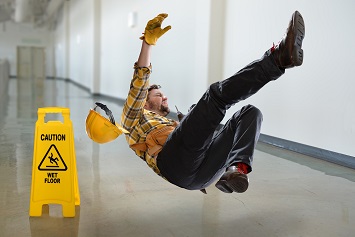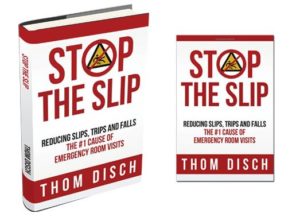We’ve had our first measurable snowfall here in the northeast, and there’s been wet weather across much of the country. While wet floors are only one component, it’s always good to revisit the problem, as slips, trips, and falls can be a perpetual thorn in the side of facilities management professionals. The hazard is so complex (and persistent across all types of industries) that it can be very difficult to manage. However, awareness is key—and to help boost awareness with strategies for fall prevention, we’re talking with Thom Disch, author of Stop the Slip: Reducing Slips, Trips and Falls, the #1 Cause of Emergency Room Visits.

ginosphotos / iStock / Getty Images Plus / Getty Images
In addition to authoring Stop the Slip, Disch is the CEO of Handi Products Inc. and owns several companies and nationally known brands, including Handi-Ramp, PetSTEP International, and Industrial Toolz, Inc. He is a leading expert and speaker on slip, trip, and fall injuries in the United States and has been compiling statistics and stories related to this healthcare crisis for ten years.
Disch notes that there are two big factors that result in a slip, trip, or fall: The why of the fall (i.e., the mental or psychological side) and the where of the fall (the physical side). But how do these variables interact, and where does the single biggest risk lie? “I really like this question because it brings out the complexity of the fall problem,” says Disch. “When you slipped and fell on that spill, was it because someone created a problem and didn’t clean up after themselves, or was it because you were on your phone and weren’t paying attention to your path? Both factors contributed, and if either was eliminated there’s a good chance the fall and possible injury would be avoided.”
This is why Disch strongly believes that the very first step in preventing fall injuries is simply increasing awareness. “Whenever I give a talk on fall prevention, many people come up to me afterward and say that just hearing about the problem has made them safer,” he says.
It’s fair to say that facilities management professionals may never be able to completely eliminate slip, trip, and fall hazards—but there are steps they can take right away to minimize the chance of a fall in their workplaces. Here are 3 big things recommended by Disch:
- Put someone in charge of slip and fall prevention. “If you have a large facility, you can split the space into smaller sections and assign area responsibilities to key individuals,” suggests Disch. “Schedule regular meetings with the fall prevention managers so that they can exchange their ideas and success stories.”
- Set up a schedule of fall prevention communications to remind everyone about the importance of fall prevention. “This memo or newsletter can include info on slips, trips, and falls in your location, but can also include fall prevention ideas for when employees are away from work,” Disch says. “Report on interesting studies or statistics, and there may even be room for a section on famous people that have suffered a fall injury.” If you’re looking for ideas on content, STOPTHESLIP.com and its blog have a great deal of current information.
- Develop a fall database that lists the details behind all falls that happen. “This is not limited to fall injuries but all falls,” clarifies Disch. “After all, fall injuries only happen after a fall! Understanding falls and where they happen will help you identify the next high-risk area for a fall injury.” Disch does warn that this may be more of a challenge than you think—employees may be reluctant to report falls because they think it’s embarrassing or that the fall may otherwise reflect poorly on themselves. “You can always try a form of anonymous reporting to increase the report rate,” he says.
Slips in the Home vs. Slips in the Workplace
There are many differences in the risks and preventive measures for slips, trips, and falls in the home vs. in the workplace—but they’re not the kind of differences you might expect.

“There are some surprising findings that we discovered when we compared fall injuries occurring at work to fall injuries at home and in the community,” says Disch. After comparing the data collected by the Bureau of Labor Statistics (BLS) that track injuries and deaths on the job to the data on fall injuries collected by the Centers for Disease Control and Prevention (CDC), Disch says he discovered that among people aged 18 to 65 (typical workforce age), 6% of all fall injuries happen while at work. That number by itself seemed low, and Disch determined he needed to put it into perspective. “We calculated the amount of time people spend at work,” Disch explains. “We only looked at times when people were at risk of falling, so we adjusted for the time when people are asleep and the amount of time people spend driving. We discovered that people on average spend 27% of their time at work.”
The question then became: If we spend 27% of our time at work, why are only 6% of all fall injuries happening at work? “My expectation was that fall injuries would be higher for people when on the job,” admits Disch. “Many occupations have an inherent greater fall risk—just think of restaurant or construction workers. But this deeper look shows we are actually safer at work. Businesses are motivated to make us safer at work. It is pure and simple finances. When they have a safer work environment, their workers’ compensation costs go down, employee productivity goes up, and even the risk of OSHA audits and fines go down.”
Since businesses have rules, processes, and people in place to prevent fall injuries, this data now makes sense. But what about that 94% of fall injuries that occur off the job? “At home and in the community, we have to act as our own safety manager,” Disch says, which naturally might give EHS professionals the advantage … but not so much the rest of the employees at the organization. “It should come as no surprise that a professionally trained safety manager who deals daily in well-thought-out safety rules and procedures will create a safer environment than we will.”
Indeed, it can be tricky to incorporate fall prevention into everything else that we pack into our busy lives. But one of the simplest things we can do to make our homes safer is to learn from our work environments. “Talk about fall prevention with other family members, reduce clutter, and fix slip hazards when they are identified,” Disch recommends.
The Ageism Question
The data collected by Disch over a decade show that the risk of falling is the same across age groups. Older people, however, have a greater chance of dying from a fall.
In a workplace with older employees, some safety professionals may feel caught between addressing this greater fatality risk and running into perceived age discrimination issues while assigning job tasks that may incur a greater risk for a fall. Disch says that it is natural that the differences between people will limit their ability to do certain tasks safely, and in the end, it’s up to the EHS pro to objectively weigh the risks.
“The fact is that when we are younger our bodies have the ability to recover more quickly, and as we age, our ability to recover from injuries slows down,” says Disch. “That has led me to say that when we are young and fall we bounce, but when we are old and fall we break. We cannot tolerate discrimination, but we also do not want to see anyone injured on the job. In my mind, safety should always be the first priority, and I don’t think there are any hard and fast rules for managing this, ultimately. I would let common sense guide these decisions.”
The Financial Costs
As you might expect, the financial costs for businesses that fail to adequately consider slip, trip, and fall risks are potentially staggering. “First of all, the overall costs attributed to falls is shocking,” says Disch. “The CDC estimated that in 2010, falls cost the U.S. economy over $150 billion in just medical costs and lost wages. To put that number in perspective, it is over 1% of our gross domestic product.”
In the workplace, fall injuries result in a wide variety of costs, with the readily apparent ones including increased workers’ compensation costs and lost productivity from the injured individual. However, the hidden costs can be much higher. Here are some examples supported by Disch’s research:
- Lost productivity from workers that were not injured. “This can be in the form of employees having to stop and help the injured worker, the cost of the paperwork required to manage the injury, and the cost to find, hire, and train a replacement,” says Disch.
- Overtime and supervisory costs. “There may be additional overtime that is incurred to fill in for the missing worker,” Disch points out, “And supervisor time may also be shifted into this area to fill a gap.”
- Trauma beyond the physical. Disch notes that “The injured employee may have unreimbursed expenses and may be affected psychologically by the fall injury.”
- Morale and reputational effects. Depending on the circumstances of the accident and how it was handled, employees companywide may be affected by a fall injury—especially if the situation was handled poorly. “This could result in lower employee morale or could even affect the reputation of the company,” says Disch.
With so much at stake, complacency is the biggest enemy. Facilities management professionals must stay aware of the risks posed by slips, trips, and falls—and ensure that employees at their organizations are doing the same! For more information, visit stoptheslip.com.
 Thom Disch is an award-winning author, speaker, and entrepreneur who is the owner and CEO of Handi Products, Inc. He holds a bachelor’s degree in economics from Oakland University and a master’s degree in management from Northwestern University. Disch was also on the faculty of DePaul University, teaching Marketing Strategy courses for their Graduate School of Business. Thom Disch is an award-winning author, speaker, and entrepreneur who is the owner and CEO of Handi Products, Inc. He holds a bachelor’s degree in economics from Oakland University and a master’s degree in management from Northwestern University. Disch was also on the faculty of DePaul University, teaching Marketing Strategy courses for their Graduate School of Business. |

